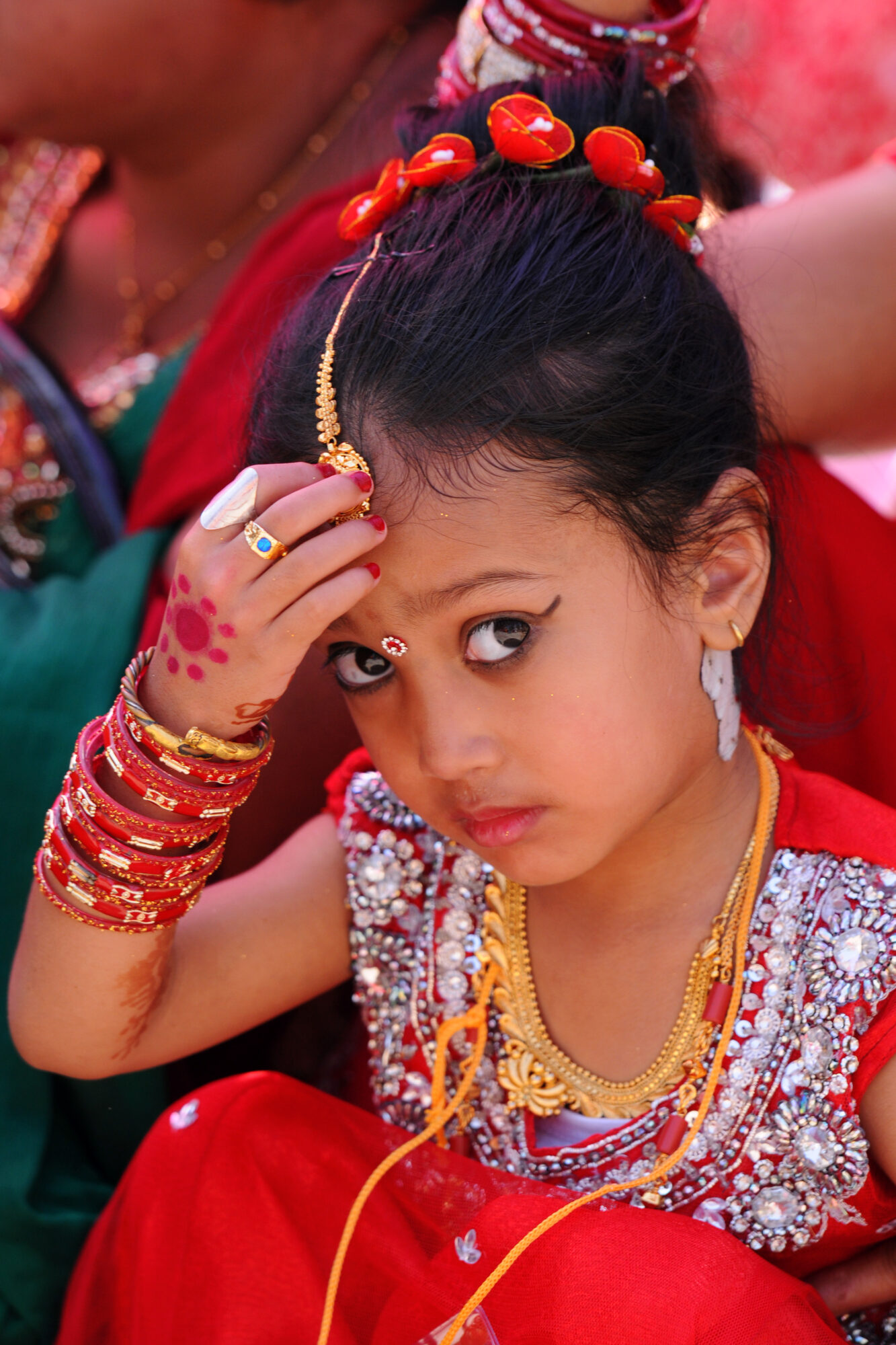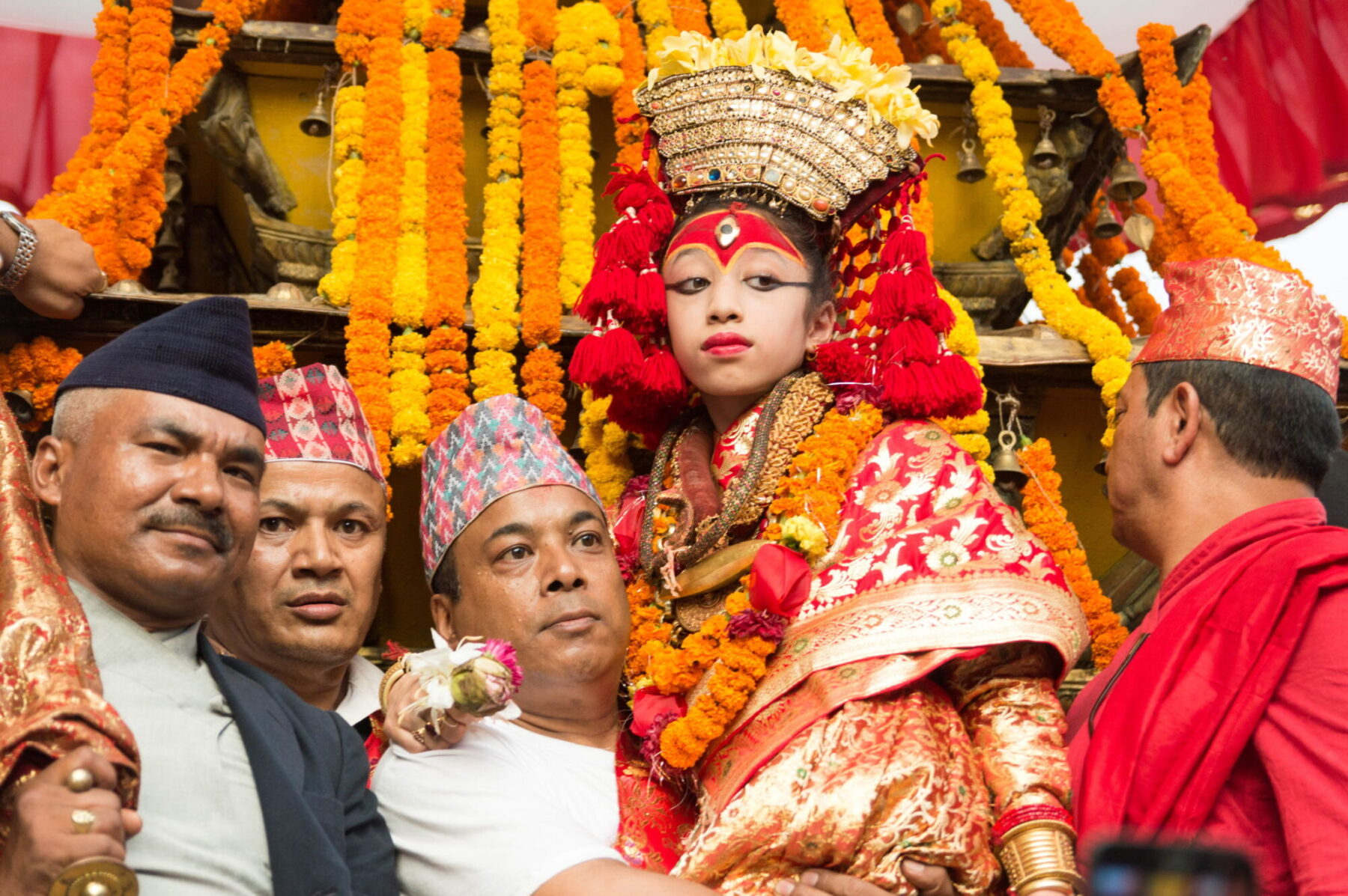Text by Khushi Makasare
In Nepal, young girls are revered as supreme deities – but not for long.
The sun rises over the Kathmandu Valley as a toddler is beautified with red and yellow face paint. She is decked in gold and silver jewellery, and her eyes are outlined with bold kohl.
This young girl is a Kumari, a manifestation of the divine female energy. She is believed to be a living goddess (devi), the incarnation Taleju, a manifestation of the Hindu goddess Durga. A Kumari’s reign can begin as young as two years old and last till the first day of her menstrual cycle.
The tradition is followed in several cities in Nepal, and as a result, there are a number of Kumaris in the country, but the best known is the Royal Kumari of the capital, Kathmandu. For the duration of her period of divinity, she resides in a palace in the city center called the Kumari Ghar. The Kumari makes short appearances at the window of this ornate brick building, attracting throngs of curious devotees for a glimpse of the girl. Kumaris live a life of seclusion – confined in the “Temple of the Living Goddess” – and rarely speak to the public.
Kumaris live a life of seclusion – confined in the “Temple of the Living Goddess” – and rarely speak to the public

THE LEGEND
While virgin worship, or Kumari-Puja, is thought to have taken place in Nepal for over 2,300 years, the current tradition of venerating a living Kumari dates from as recently as the 17th century CE. A variety of legends tell of how the tradition began, the most popular involving the last king of the Malla Dynasty (12th-17th century), King Jayaprakash Malla. In the dark of the night, the goddess Taleju would secretly meet with the king in his chambers – to play the traditional Nepalese dice game Tripasa. Growing suspicious of her husband, the king’s wife followed him one night and uncovered their secret, angering the goddess. Taleju told the king that if he wanted to continue seeing her, he would have to find a young girl from the Newari community whose body the goddess could possess. And thus began an age-old tradition as the king set out to find a “pure” young girl who would serve as the incarnated Taleju.
AUDITION FOR THE TITLE
Patan, Bhaktapur, Kathmandu, Bungamati and other Newari communities have their own Kumaris, but the Royal Kumari of Kathmandu is the most well-known. While the Kumari is selected by the Nepalese Newari Buddhist community, she is also worshiped by Hindus in the region. The tradition borrows elements of both religions and blends them when selecting and nurturing the goddess. But how is a girl determined to be fit for the role?
Families volunteer their daughters from a young age, and the girls’ courage is put to the test. Dressed in the goddess’s traditional red, they are brought before five Vajracharya priests – the Panch Buddha, the Bada Guruju (Chief Royal Priest), Achajau, the priest of Taleju, and the royal astrologer. According to the commonly understood screening process, the priests select eligible girls from the Newar Shakya caste of silversmiths and goldsmiths. Candidates must be healthy, have no blemishes on their bodies, and have lost neither blood nor teeth.

The lucky few are then assessed based on the battis lakhshanas, or “thirty-two perfections” of a goddess, beauty ideals expressed in a rather poetic language, including “a neck like a conch shell”, “a body like a banyan tree” , “eyelashes like a cow”, “thighs like a deer”, “a chest like a lion” and “a voice soft and clear as a duck’s”. Among other physical requirements, hair and eyes must be very black, teeth must be numbered and hands 20, and feet should be dainty. The contenders’ horoscopes must also align with that of the king, while the piety and devotion to the king of the girls’ families must be unquestioned. The lucky few are then assessed based on the battis lakhshanas, or “thirty-two perfections” of a goddess.
The chosen candidate is obliged to undergo a final bizarre test of courage to prove she is indeed a worthy vessel for Taleju. In her autobiography, Rashmila Shakya, a former Royal Kumari, describes the ritual of decapitated animal heads presented to her as a test of her fearlessness. Girls are observed for any reaction, and crying results in their elimination. She also says that there were no masked men dancing around trying to scare her, contrary to popular belief. Once the girl passes the series of tests, her body is cleansed in the Taleju Temple via various tantric rituals, before the spirit of Taleju enters her. Dressed as a Kumari, she is carried from the temple to the Kumari Ghar, where she remains throughout her appointment.

LIFE AS A KUMARI
The Kumari takes on many roles in society. Her actions however small – are believed to predict – the future. If she’s crying, it might indicate death; if she’s clapping, there is a reason to fear the king.
She is visited by locals, tourists, government officials, and even the royal family. They come bearing gifts for the girl. While she meets with them, she is not allowed to speak to them. Her immediate family members are the only people she is allowed to talk to. In her leisure time, she plays in her courtyard with other Newari children. Traditionally, Kumaris did not receive an education, but today, they attend a school or receive their education through private tutors.
As a goddess, she is treated above all. Her feet never touch the floor – she is always carried in someone’s arms or her palanquin when outside the Kumari Ghar. The living goddess is clad in red and adorned with gold jewellery. Out of respect for their daughter being the “chosen one”, her family performs the nitya puja ritual every morning.
The Royal Kumari only leaves her temple to observe religious festivals in Kathmandu. Of the many festivals, Indra Jatra is one of the most important. The eight-day-long celebration marks the end of the monsoon season.

A FADING TRADITION
Like many age-old customs, the Kumari tradition is dying out, with fewer families bringing forth their daughters to be judged to become the next living goddess. The shrinking candidate pool in recent years has been a concern to the priesthood. After all, with no one to occupy the throne, the deity would not have a body in which to reside.
Fewer parents are willing to volunteer their prepubescent daughters and sacrifice their formative years. An increasing majority of families are striving to give their daughters a more liberal life with education, friends, and real-world experiences. Parents are aware that the Kumari’s isolation has consequences for the girl’s mental health and her social skills.
While supporters of the Kumari tradition might lament the demise of a cherished facet of Nepali culture, its detractors argue that the practice has no place in modern Nepal, which attaches importance to girls’ education and the value of women in society and the workplace. Either way, the manifestation of the goddess Taleju in child form remains a profound demonstration of the potency of belief.
In Asian Geographic’s Issue No. 153, Religion is decoded as we delve into the major world religions. Covering Christianity, Buddhism, Islam, Hinduism and Sikhism.
This issue follows the rise and fall of these major religions as well as the practices and traditions that have stood the test of time. Journey through the history of these religions and gain a deeper understanding of the beliefs that inspire such deep devotion and faith in their followers.
Pick up your copy here











